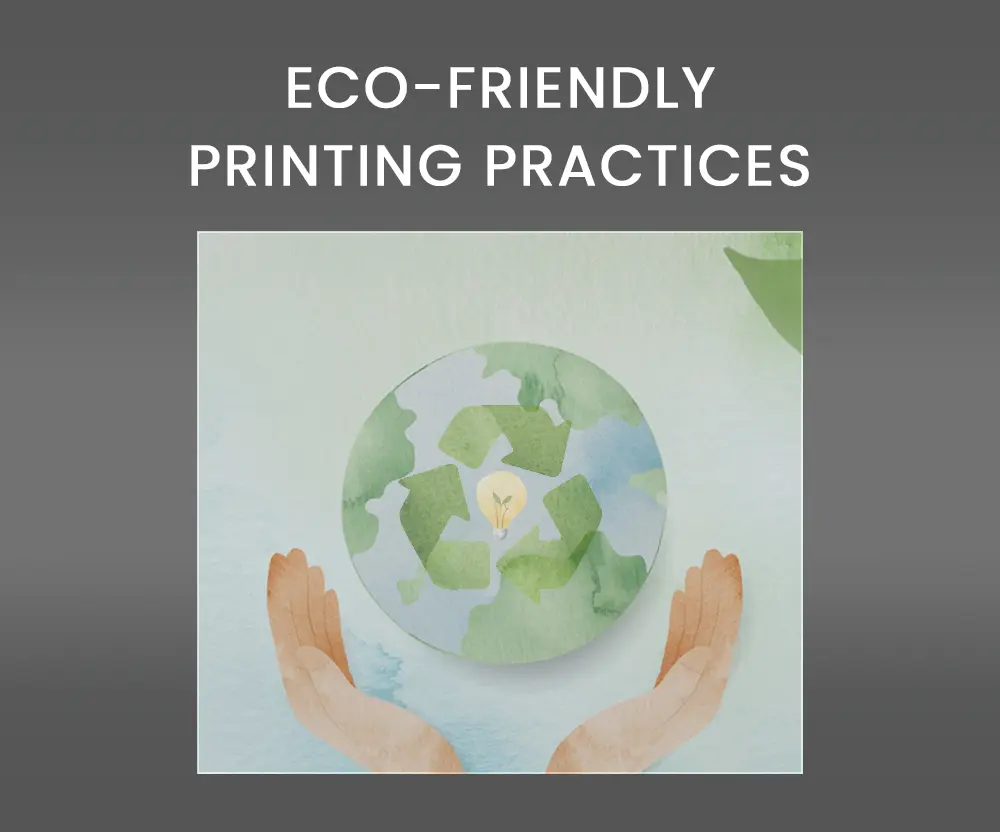In an era where environmental concerns have taken center stage, the printing industry is making significant strides toward sustainability. The adoption of eco-friendly practices, materials, and technologies has become a priority for both print service providers and consumers alike. One of the key areas where sustainability is making a difference is in the choice of ink and paper options. In this comprehensive exploration, we will delve into the eco-friendly alternatives available in the world of printing, focusing on ink and paper choices that reduce environmental impact while maintaining high-quality results.
The Environmental Impact of Printing
Before delving into eco-friendly options, it’s essential to understand the profound environmental impact of traditional printing processes. Conventional printing methods often involve the use of petroleum-based inks and paper derived from tree pulp. These practices can have adverse effects on forests, water resources, and air quality due to the emission of volatile organic compounds (VOCs) during the printing process.
Additionally, the disposal of printed materials contributes to landfill waste, as paper can take years to decompose fully. To address these issues, the printing industry is embracing sustainability by adopting greener alternatives that minimize harm to the environment.
Eco-Friendly Ink Options

- Vegetable-Based Inks: Vegetable-based inks are derived from renewable resources such as soybeans, flax, and linseed. These inks contain fewer VOCs than their petroleum-based counterparts, resulting in reduced air pollution during the printing process. Vegetable-based inks also offer vibrant color options and are compatible with various printing methods, making them a sustainable choice for a wide range of applications.
- Water-Based Inks: Water-based inks are another eco-friendly option that significantly reduces VOC emissions. These inks are composed primarily of water, which means they produce fewer harmful chemicals during printing. Water-based inks are commonly used in digital and screen printing, particularly for textiles and packaging materials. They are known for their excellent color saturation and ability to produce sharp images.
- UV-Curable Inks: UV-curable inks are cured instantly using ultraviolet (UV) light, eliminating the need for solvents and reducing emissions. These inks are suitable for a variety of printing applications, including wide format and large format printing. UV-curable inks are durable and resistant to fading, making them an eco-friendly choice for outdoor signage and displays.
- Bio-Based Inks: Bio-based inks are made from renewable resources such as algae, corn, or other plant-based materials. They are an innovative and sustainable alternative to traditional inks. Bio-based inks are biodegradable and offer excellent color quality. While they are not yet as widely adopted as other eco-friendly inks, they hold promise for a greener printing future.
- Recycled Inks: Recycled inks are another emerging eco-friendly option. These inks are made from reprocessed and re-refined ink cartridges. While they may not be suitable for all printing applications, they represent a circular economy approach by reducing waste and the need for new raw materials. Recycled inks are an excellent example of how the printing industry is finding innovative solutions to reduce its environmental footprint.
- Low-VOC Inks: In addition to the ink composition itself, low-VOC (volatile organic compound) inks are gaining popularity. These inks reduce emissions of harmful chemicals during the printing process, contributing to improved air quality in printing facilities and reduced environmental impact.
- LED-Curable Inks: LED-curable inks are energy-efficient and emit less heat than traditional curing methods. This technology reduces energy consumption and enhances the sustainability of the printing process.
Sustainable Paper Choices
- Recycled Paper: Recycled paper is an eco-friendly option that helps reduce the demand for virgin wood pulp. It is available in various grades and is suitable for a wide range of printing applications, from brochures to packaging. Recycled paper retains the quality and appearance of traditional paper while conserving natural resources. It can contain varying percentages of post-consumer waste, with higher percentages indicating a more sustainable option. Many consumers and businesses are unaware that recycled paper can match or even surpass the quality of non-recycled paper, making it an easy and impactful choice for sustainability.
- FSC-Certified Paper: The Forest Stewardship Council (FSC) certifies paper products sourced from sustainably managed forests. Choosing FSC-certified paper ensures that the raw materials used in paper production come from responsibly managed forests. FSC-certified paper is available in various finishes and weights, making it suitable for both commercial and artistic printing. This certification provides a clear indication of responsible forest management.
- Tree-Free Paper: Tree-free paper is made from alternative fibers such as cotton, hemp, or bamboo. These fibers grow faster than trees, making them a more sustainable source of pulp. Tree-free paper is an excellent choice for environmentally conscious consumers and businesses. It is often used for premium stationery, packaging, and high-quality art prints. Tree-free paper is also known for its durability and resistance to yellowing, ensuring that prints maintain their quality over time.
- Biodegradable and Compostable Paper: Biodegradable and compostable papers are designed to break down naturally, reducing the environmental impact of disposal. These papers are ideal for short-term use items like event posters and flyers. When disposed of properly, they return to the soil without leaving behind harmful residues. It’s essential to follow specific disposal guidelines to ensure that these papers break down effectively.
- Algae-Based Paper: Algae-based paper is an innovative and sustainable option that harnesses the rapid growth of algae to create paper products. This process requires fewer resources and reduces the environmental impact of traditional paper production. Algae-based paper shows promise as a highly sustainable alternative.
Advantages of Eco-Friendly Printing

- Reduced Environmental Footprint: The use of eco-friendly inks and paper options reduces the environmental impact of printing. It conserves natural resources, reduces pollution, and promotes responsible forestry practices. By opting for eco-friendly printing materials, individuals and businesses can contribute to mitigating deforestation and habitat destruction, preserving ecosystems for future generations.
- Healthier Indoor Air Quality: Eco-friendly inks emit fewer VOCs during the printing process, leading to improved indoor air quality in printing facilities. This benefits both workers and the surrounding environment, creating safer and more pleasant working conditions. Employees working in environments with lower VOC emissions are less likely to experience health issues related to poor indoor air quality, such as respiratory problems and eye irritation.
- Enhanced Brand Image: Businesses that prioritize sustainability can enhance their brand image by choosing eco-friendly printing materials. This demonstrates a commitment to environmental responsibility, which can resonate positively with customers and partners. Eco-friendly packaging, for example, can convey a message of environmental consciousness to consumers, potentially leading to increased brand loyalty and trust.
- Compliance with Regulations: Using eco-friendly printing materials helps businesses comply with environmental regulations and standards. It reduces the risk of fines and penalties associated with environmental non-compliance, promoting legal and ethical printing practices. Staying ahead of environmental regulations can also position businesses as responsible corporate citizens and leaders in sustainable practices within their industries.
Challenges and Considerations
While eco-friendly ink and paper options offer numerous benefits, there are some considerations to keep in mind:
- Cost: Eco-friendly printing materials can be more expensive than their conventional counterparts. However, the cost difference is decreasing as sustainability becomes more mainstream. In some cases, the long-term environmental benefits may outweigh the initial cost, as businesses and consumers increasingly value sustainability.
- Compatibility: Not all printing processes and equipment are compatible with eco-friendly inks. It’s essential to ensure that your printing equipment can handle these materials effectively. Retrofitting or upgrading may be necessary in some cases. Additionally, printing with eco-friendly inks may require adjustments to printing settings and processes to achieve optimal results.
- Availability: The availability of eco-friendly printing materials may vary by region. Businesses may need to work closely with suppliers to source these materials. As demand for eco-friendly options increases, availability is likely to improve, making it easier for businesses to access sustainable printing materials.
- Certifications: When selecting eco-friendly paper, look for certifications such as FSC or Cradle to Cradle to ensure that the product meets sustainability standards. These certifications provide third-party validation of a product’s environmental claims and offer assurance that the materials meet specific criteria for responsible sourcing and production.
Sustainability in printing is no longer a niche concept; it’s a growing trend driven by environmental awareness and responsible business practices. The adoption of eco-friendly ink and paper options offers numerous benefits, ranging from reduced environmental impact to improved indoor air quality. By making sustainable choices in the printing process, businesses and individuals can contribute to a greener future while still achieving high-quality and visually appealing results.
As eco-friendly printing options continue to evolve and become more accessible, they are poised to play an increasingly significant role in the printing industry’s efforts to reduce its carbon footprint and environmental impact. By embracing these alternatives, the printing industry can demonstrate its commitment to sustainable practices while meeting the demands of an environmentally conscious market. Sustainable printing is not just a choice; it’s a responsible path forward for the industry and the planet. As the sustainability movement gains momentum, eco-friendly printing is positioned to lead the way toward a more environmentally friendly and responsible future. The printing industry has the opportunity to drive positive change and set a high standard for sustainability across all sectors.





